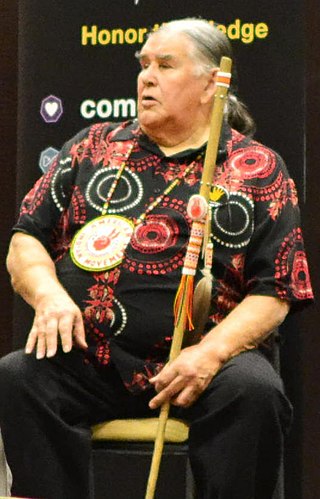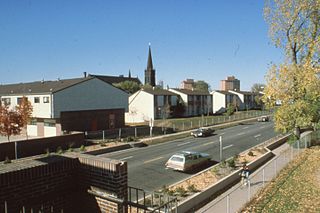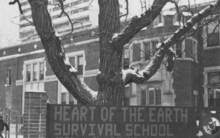
Gerald Robert Vizenor is an American writer and scholar, and an enrolled member of the Minnesota Chippewa Tribe, White Earth Reservation. Vizenor also taught for many years at the University of California, Berkeley, where he was Director of Native American Studies. With more than 30 books published, Vizenor is Professor Emeritus at the University of California, Berkeley, and Professor of American Studies at the University of New Mexico.

The American Indian Movement (AIM) is an American Indian grassroots movement which was founded in Minneapolis, Minnesota in July 1968, initially centered in urban areas in order to address systemic issues of poverty, discrimination, and police brutality against American Indians. AIM soon widened its focus from urban issues to many Indigenous Tribal issues that American Indian groups have faced due to settler colonialism in the Americas. These issues have included treaty rights, high rates of unemployment, the lack of American Indian subjects in education, and the preservation of Indigenous cultures.

The Red Lake Indian Reservation covers 1,260.3 sq mi in parts of nine counties in Minnesota, United States.

Dennis Banks was a Native American activist, teacher, and author. He was a longtime leader of the American Indian Movement, which he co-founded in Minneapolis, Minnesota in 1968 to represent urban Indians.

Clyde Howard Bellecourt was a Native American civil rights organizer. His Ojibwe name is Nee-gon-we-way-we-dun, which means "Thunder Before the Storm". He founded the American Indian Movement (AIM) in Minneapolis, Minnesota, in 1968 with Dennis Banks, Eddie Benton-Banai, and George Mitchell. His elder brother, Vernon Bellecourt, was also active in the movement.

The Leech Lake Reservation is an Indian reservation located in the north-central Minnesota counties of Cass, Itasca, Beltrami, and Hubbard. The reservation forms the land base for the federally recognized Leech Lake Band of Ojibwe, one of six bands comprising the Minnesota Chippewa Tribe, organized in 1934. The Leech Lake Reservation has the second highest population of any reservation in Minnesota with White Earth Nation being the largest Minnesota Ojibwe tribe, Leech Lake Nation has a resident population of 11,388 indicated by the 2020 census.

The Leech Lake Band of Ojibwe, also known as the Leech Lake Band of Chippewa Indians or the Leech Lake Band of Minnesota Chippewa Tribe is an Ojibwe band located in Minnesota and one of six making up the Minnesota Chippewa Tribe. The band had 9,426 enrolled tribal members as of March 2014. The band's land base is the Leech Lake Indian Reservation, which includes eleven communities aggregated into three districts, as defined in the tribal constitution,
The Minnesota Indian Affairs Council (MIAC) is an intergovernmental body established by the U.S. state of Minnesota to serve as a liaison between state government and the Native American tribes residing within the state's boundaries. Created by the Minnesota Legislature, MIAC aims to improve relationships, facilitate dialogue, and address issues of mutual concern between the State of Minnesota and the tribal governments. The council plays a critical role in advising on policy, advocating for indigenous rights, and promoting cultural understanding.

The Northern Cheyenne Tribe of the Northern Cheyenne Indian Reservation is the federally recognized Northern Cheyenne tribe. Located in southeastern Montana, the reservation is approximately 690 square miles (1,800 km2) in size and home to approximately 6,000 Cheyenne people. The tribal and government headquarters are located in Lame Deer, also the home of the annual Northern Cheyenne pow wow.

The Sisseton Wahpeton Oyate of the Lake Traverse Reservation, formerly Sisseton-Wahpeton Sioux Tribe/Dakota Nation, is a federally recognized tribe comprising two bands and two subdivisions of the Isanti or Santee Dakota people. They are on the Lake Traverse Reservation in northeast South Dakota.

The Bureau of Indian Education (BIE), headquartered in the Main Interior Building in Washington, D.C., and formerly known as the Office of Indian Education Programs (OIEP), is a division of the U.S. Department of the Interior under the Assistant Secretary for Indian Affairs. It is responsible for the line direction and management of all BIE education functions, including the formation of policies and procedures, the supervision of all program activities, and the approval of the expenditure of funds appropriated for BIE education functions.

Little Earth is a residential housing area in Minneapolis, Minnesota, United States that is home to nearly 1,500 people, many of whom are American Indian. The residential housing association at Little Earth considers itself a united people of 39 different American Indian tribes, but the area is not an urban reservation, a common mischaracterization. Little Earth is located in the Phillips community of Minneapolis. While being a notable district, it is not one of the officially designated neighborhoods in the city.

Dodging Bullets—Stories from Survivors of Historical Trauma is a documentary film on historical trauma in Indian country, co-directed by Kathy Broere (Blackfeet), Sarah Edstrom, Jonathan Thunder, and Bob Trench, and produced by Larry Long with soundtrack by Keith Secola. The film focuses on historical events and how they inter-generationally affect the Indigenous population in North America today. It premiered at the Minneapolis–Saint Paul International Film Festival where it was awarded "Best of Fest" and was awarded The Samuel Sprynczynatyk Storyteller Award: Best Documentary Feature at the North Dakota Human Rights Film Festival. Filmed across the lands of the Plains Indians, which is now known as Wisconsin, Minnesota, the Dakotas, Nebraska, Colorado, and Montana, the film recalls first-hand storytelling that reflects how past generations were deeply impacted by mass trauma and how that trauma influences Indigenous peoples of the Americas today. The film ends on a positive path to healing through ceremony and cultural identity.
Walt Pourier is an American skateboarder, artist, designer, and skateboarding activist. Pourier is Oglala Lakota.
Metro Deaf School (MDS) is a birth–12+ free charter school in St. Paul, Minnesota that serves Deaf, Hard of Hearing, and DeafBlind students throughout the Twin Cities. Its mission is to promote academic excellence and social wellbeing for Deaf, DeafBlind and Hard-of-Hearing students using an ASL/English bilingual approach.
Circle of Nations Wahpeton Indian School, formerly Wahpeton Indian School, is a tribally-controlled grade 4-8 school in Wahpeton, North Dakota.
Crazy Horse School is a tribally-controlled K-12 school in Wanblee, South Dakota. It is affiliated with the Bureau of Indian Education (BIE). It is within the Pine Ridge Indian Reservation.
Fond du Lac Ojibwe School is a K–12 tribal school in Cloquet, Minnesota. The Fond du Lac Band of Lake Superior Chippewa operates the school and owns the facilities.
Nay Ah Shing School, also known as Mille Lacs Band K-12 Schools, is a K-12 tribal school system headquartered in unincorporated Mille Lacs County, Minnesota, with an Onamia postal address. It is affiliated with the Bureau of Indian Education (BIE). It is on the Mille Lacs Indian Reservation.
Bug-O-Nay-Ge-Shig School is a K-12 tribal school in unincorporated Cass County, Minnesota, near Bena. It is affiliated with the Bureau of Indian Education (BIE). Located on the Leech Lake Indian Reservation, it serves the Leech Lake Band of Ojibwe. It is nicknamed the "Bug School".













